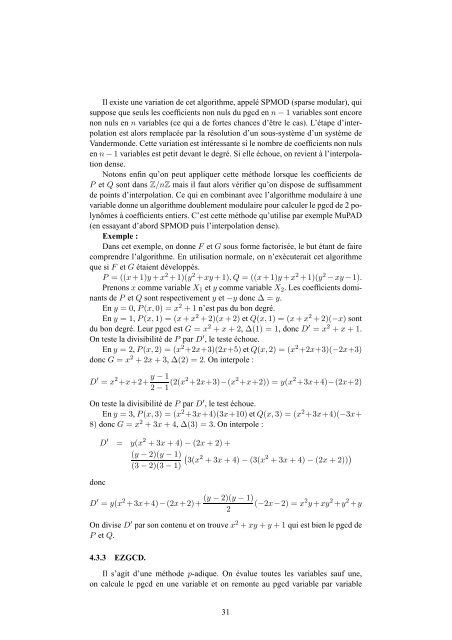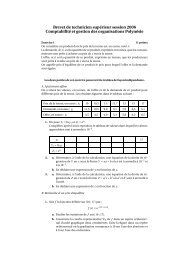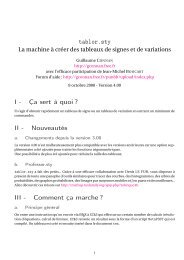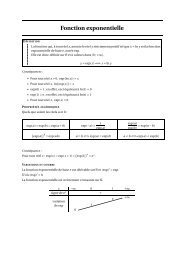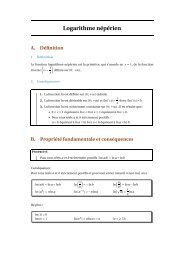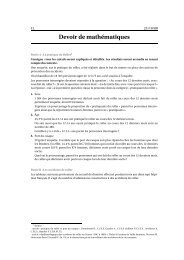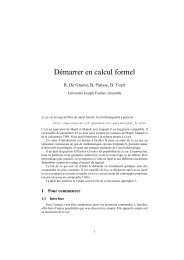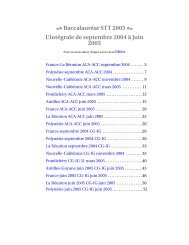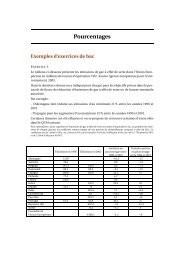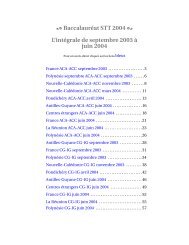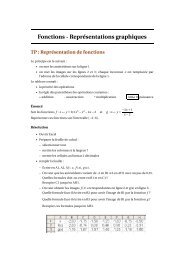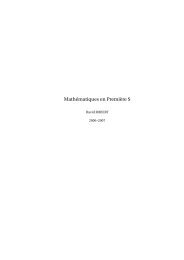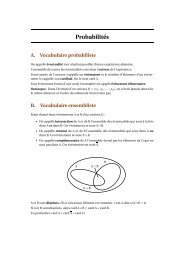donc∆(α)G/lcoeff(G) = D ′ (X 1 , . . .., X n−1 , α)Algorithme du pgcd modulaire à plusieurs variables (interpolation <strong>de</strong>nse) :Arguments : 2 polynômes primitifs P et Q <strong>de</strong> n variables X 1 , . . .., X n à coefficientsentiers. Renvoie le pgcd <strong>de</strong> P et Q.1. Si n = 1, renvoyer le pgcd <strong>de</strong> P et Q en une variable.2. Test rapi<strong>de</strong> <strong>de</strong> pgcd trivial par rapport à X n . On cherche <strong>de</strong>s n − 1-uplets αtels que P(α, X n ) et Q(α, X n ) soient <strong>de</strong> même <strong>de</strong>gré que P et Q par rapportà la variable X n . On <strong>calcul</strong>e le pgcd G <strong>de</strong> ces 2 polynômes en une variable.Si le pgcd est constant, alors on retourne le pgcd <strong>de</strong>s coefficients <strong>de</strong> P et Q.3. On divise P et Q par leur contenu respectifs vu comme polynômes en X 1 , . . .., X n−1à coefficients dans Z[X n ], on note C(X n ) le pgcd <strong>de</strong>s contenus. On <strong>calcul</strong>eaussi le pgcd ∆(X n ) <strong>de</strong>s coefficients dominants <strong>de</strong> P et <strong>de</strong> Q.4. On initialise D ′ le pgcd reconstruit à 0, I(X n ) le polynôme d’interpolationà 1, δ = (δ 1 , ..., δ n−1 ) la liste <strong>de</strong>s <strong>de</strong>grés partiels du pgcd par rapport àX 1 , . . .., X n−1 au minimum <strong>de</strong>s <strong>de</strong>grés partiels <strong>de</strong> P et Q par rapport àX 1 , . . .., X n−1 , e le nombre d’évaluation à 0 et E l’ensemble <strong>de</strong>s pointsd’interpolation à la liste vi<strong>de</strong>.5. Boucle infinie :– Faire α=entier aléatoire n’appartenant pas à E jusqu’à ce que<strong>de</strong>gre(P(X 1 , . . .., X n−1 , α))=<strong>de</strong>gre Xn(P(X 1 , . . .., X n )<strong>de</strong>gre(Q(X 1 , . . .., X n−1 , α)) = <strong>de</strong>gre Xn(Q(X 1 , . . .., X n ))– Calculer le pgcd G(X 1 , . . .., X n−1 ) en n−1 variables <strong>de</strong> P(X 1 , . . .., X n−1 , α)et Q(X 1 , . . .., X n−1 , α).– Si <strong>de</strong>gre(G) i < δ i pour un indice au moins. Si <strong>de</strong>gre(G) δ, on poseδ = <strong>de</strong>gre(G), D ′ = G ∆(α) , I = X lcoeff(G)n − α, e = 1 et E = [α], sinonon pose δ = min(δ, <strong>de</strong>gre(G)), D ′ = 0, I = 1, e = 0, E = []. On passe àl’itération suivante.– Si <strong>de</strong>gre(G) > δ, on passe à l’itération suivante.– Si <strong>de</strong>gre(G) = δ, on interpole :– G := G ∆(α)lcoeff(G)– D ′ := D ′ I(X+ n)Qα j ∈E (α−α j) (G − D′ (X 1 , . . .., X n−1 , α))– I := I ∗ (X n − α)– e := e + 1 et ajouter α à E– Si e est strictement plus grand que le minimum <strong>de</strong>s <strong>de</strong>grés partiels <strong>de</strong> Pet Q par rapport à X n , on pose ˜D la partie primitive <strong>de</strong> D ′ (vu commepolynôme à coefficients dans Z[X n ]), on teste si P et Q sont divisiblespar ˜D, si c’est le cas, on renvoie D = C(X n ) ˜DOn observe que dans cet algorithme, on fait le test <strong>de</strong> divisibilite <strong>de</strong> ˜D par P etQ. En effet, même après avoir évalué en suffisamment <strong>de</strong> points, rien n’indiqueque tous ces points sont <strong>de</strong>s points <strong>de</strong> bonne évaluation. En pratique cela resteextrêmement improbable. En pratique, on teste la divisibilité plus tôt, dès que D ′n’est pas modifié par l’ajout d’un nouveau point à la liste <strong>de</strong>s α j .30
Il existe une variation <strong>de</strong> cet algorithme, appelé SPMOD (sparse modular), quisuppose que seuls les coefficients non nuls du pgcd en n − 1 variables sont encorenon nuls en n variables (ce qui a <strong>de</strong> fortes chances d’être le cas). L’étape d’interpolationest alors remplacée par la résolution d’un sous-système d’un système <strong>de</strong>Van<strong>de</strong>rmon<strong>de</strong>. Cette variation est intéressante si le nombre <strong>de</strong> coefficients non nulsen n − 1 variables est petit <strong>de</strong>vant le <strong>de</strong>gré. Si elle échoue, on revient à l’interpolation<strong>de</strong>nse.Notons enfin qu’on peut appliquer cette métho<strong>de</strong> lorsque les coefficients <strong>de</strong>P et Q sont dans Z/nZ mais il faut alors vérifier qu’on dispose <strong>de</strong> suffisamment<strong>de</strong> points d’interpolation. Ce qui en combinant avec l’algorithme modulaire à unevariable donne un algorithme doublement modulaire pour <strong>calcul</strong>er le pgcd <strong>de</strong> 2 polynômesà coefficients entiers. C’est cette métho<strong>de</strong> qu’utilise par exemple MuPAD(en essayant d’abord SPMOD puis l’interpolation <strong>de</strong>nse).Exemple :Dans cet exemple, on donne F et G sous forme factorisée, le but étant <strong>de</strong> fairecomprendre l’algorithme. En utilisation normale, on n’exécuterait cet algorithmeque si F et G étaient développés.P = ((x+1)y +x 2 +1)(y 2 +xy+1), Q = ((x+1)y +x 2 +1)(y 2 −xy −1).Prenons x comme variable X 1 et y comme variable X 2 . Les coefficients dominants<strong>de</strong> P et Q sont respectivement y et −y donc ∆ = y.En y = 0, P(x,0) = x 2 + 1 n’est pas du bon <strong>de</strong>gré.En y = 1, P(x,1) = (x+x 2 +2)(x+2) et Q(x,1) = (x+x 2 +2)(−x) sontdu bon <strong>de</strong>gré. Leur pgcd est G = x 2 + x + 2, ∆(1) = 1, donc D ′ = x 2 + x + 1.On teste la divisibilité <strong>de</strong> P par D ′ , le teste échoue.En y = 2, P(x,2) = (x 2 +2x+3)(2x+5) et Q(x,2) = (x 2 +2x+3)(−2x+3)donc G = x 2 + 2x + 3, ∆(2) = 2. On interpole :D ′ = x 2 +x+2+ y − 12 − 1 (2(x2 +2x+3)−(x 2 +x+2)) = y(x 2 +3x+4)−(2x+2)On teste la divisibilité <strong>de</strong> P par D ′ , le test échoue.En y = 3, P(x,3) = (x 2 +3x+4)(3x+10) et Q(x,3) = (x 2 +3x+4)(−3x+8) donc G = x 2 + 3x + 4, ∆(3) = 3. On interpole :doncD ′ = y(x 2 + 3x + 4) − (2x + 2) +(y − 2)(y − 1) (3(x 2 + 3x + 4) − (3(x 2 + 3x + 4) − (2x + 2)) )(3 − 2)(3 − 1)D ′ = y(x 2 +3x+4)−(2x+2)+(y − 2)(y − 1)(−2x−2) = x 2 y+xy 2 +y 2 +y2On divise D ′ par son contenu et on trouve x 2 + xy + y + 1 qui est bien le pgcd <strong>de</strong>P et Q.4.3.3 EZGCD.Il s’agit d’une métho<strong>de</strong> p-adique. On évalue toutes les variables sauf une,on <strong>calcul</strong>e le pgcd en une variable et on remonte au pgcd variable par variable31


